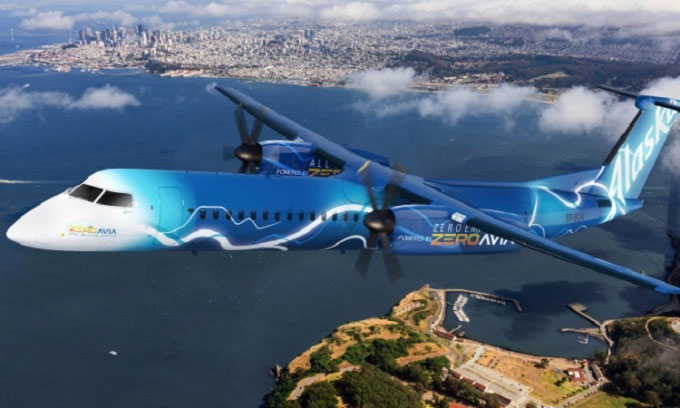Development and testing of the world's largest zero-emissions commercial aircraft
Alaska Air Group and ZeroAvia are developing and testing an improved De Havilland Q400 76-seat aircraft with a range of 805km.
Alaska Air Group , the parent company of Alaska Airlines, on October 26 announced a partnership with hydrogen-electric aircraft developer ZeroAvia to create a zero-emission passenger plane for domestic flights . According to Pasha Saleh, chief development officer for Alaska Airlines, the aviation operating environment is the best laboratory to test and demonstrate the effectiveness of new technology.

Zero-emission hydrogen-electric aircraft design by Alaska Air Group and ZeroAvia. (Photo: Alaska Airlines)
After a year of development, ZeroAvia will equip a hydrogen-electric powertrain for the De Havilland DHC-8-400 (Q400) aircraft . The ZA2000 powertrain will have a capacity of 2,000 - 5,000 kW. Alaska Airlines will help ZeroAvia scale the technology to be installed on its planes.
The test aircraft with a maximum range of 805 km will help Alaska Airlines achieve its zero-carbon goal by 2040. ZeroAvia is planning to base the project in Seattle. They are working closely with regulators to ensure the aircraft meets safety and operational standards.
"The reason we're doing this is because airlines can play a big role in making zero-emissions electric aircraft a reality. Through this collaborative project, we're one country closer to the future. The goal is to make the sky clean of emissions," shared Val Miftakhov, CEO and founder of ZeroAvia.
Hydrogen fuel cell aircraft have the potential to increase range by using hydrogen to create a chemical reaction that produces electricity. Hydrogen also has a 100 times higher energy-to-mass ratio than lithium-ion batteries, which are too bulky for aircraft. However, researchers still need further testing to prove the feasibility of hydrogen fuel cell aircraft.
- The world's largest aircraft successfully tested
- The ancestor cannot be identified by DNA testing
- Video: The supersonic jet commercial aircraft is about to be released
- Why don't commercial planes fly higher into space?
- NASA speeds up development of
- What happens when a helicopter 'wants to fly but does not fly'?
- Airbus filed a patent for a new super fast aircraft design
- 'Made in China' is about to take off for the first time
- Testing biofuel for aircraft
- China designed aircraft to take passengers to visit the universe
- Canada tested the world's first all-electric all-electric aircraft
- The world's largest aircraft has 6 Boeing 747 engines taking off for the first time
 The US company is about to build a supersonic passenger plane of 6,000km / h
The US company is about to build a supersonic passenger plane of 6,000km / h Japan develops avatar robot as in fiction film
Japan develops avatar robot as in fiction film Australia tested the world's first mango picking robot
Australia tested the world's first mango picking robot America develops technology to separate water from animal waste
America develops technology to separate water from animal waste